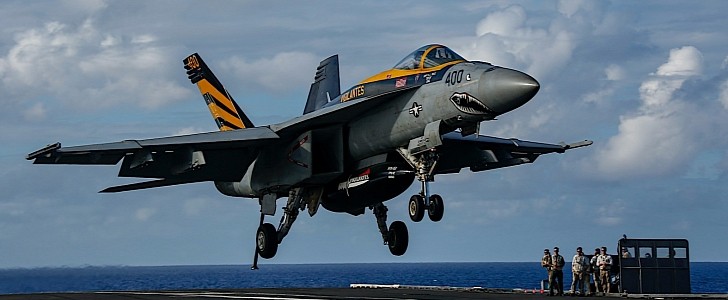Airplanes operating from aircraft carriers are amazing in many ways. First, because they’re military aircraft and they always conjure up all sorts of feelings in the onlooker. Secondly, because of the way they take off, using a catapult to shoot them at the speeds required to get them off the short decks. And thirdly, because of the way they land.
To come to a safe stop when landing on carrier decks, aircraft need to decelerate rapidly, due to the limited space available. Most of these planes cannot do that on their own, so carriers are equipped with arresting gear, which is used to help fighters perform an arrested landing.
Such technologies came into existence as early as 1911, when American aviation pioneer Eugene Ely used cables ran through pulleys and deadweights to get his Curtiss Pusher airplane on a platform fitted to the USS Pennsylvania armored cruiser.
Needless to say, arresting gear evolved a great since then. The USS Abraham Lincoln (CVN 72), for instance, has four catch wires in place on which incoming aircraft to grab on with their tail hooks. The energy generated by the landing is sent to damping systems, which help bring the plane to a smooth stop.
The F/A-18E Super Hornet, wearing body tattoos (including a snarling mouth on the nose), was about to go through exactly such an operation earlier this month, on the carrier we mentioned above, when it was caught on camera and earned its place in our Photo of the Day section.
The plane is part of Strike Fighter Squadron (VFA) 151, aka Vigilantes, using the Lincoln as a base of operations. Deployed with the larger Abraham Lincoln Carrier Strike Group, the unit and others like it are presently deployed in the U.S. 7th Fleet area of operations, namely in the Philippine Sea.
The strike group is there, says the Navy, “to enhance interoperability through alliances and partnerships while serving as a ready-response force in support of a free and open Indo-Pacific region.”
Such technologies came into existence as early as 1911, when American aviation pioneer Eugene Ely used cables ran through pulleys and deadweights to get his Curtiss Pusher airplane on a platform fitted to the USS Pennsylvania armored cruiser.
Needless to say, arresting gear evolved a great since then. The USS Abraham Lincoln (CVN 72), for instance, has four catch wires in place on which incoming aircraft to grab on with their tail hooks. The energy generated by the landing is sent to damping systems, which help bring the plane to a smooth stop.
The F/A-18E Super Hornet, wearing body tattoos (including a snarling mouth on the nose), was about to go through exactly such an operation earlier this month, on the carrier we mentioned above, when it was caught on camera and earned its place in our Photo of the Day section.
The plane is part of Strike Fighter Squadron (VFA) 151, aka Vigilantes, using the Lincoln as a base of operations. Deployed with the larger Abraham Lincoln Carrier Strike Group, the unit and others like it are presently deployed in the U.S. 7th Fleet area of operations, namely in the Philippine Sea.
The strike group is there, says the Navy, “to enhance interoperability through alliances and partnerships while serving as a ready-response force in support of a free and open Indo-Pacific region.”











